Eight Things You Need to Know About the 488 Pista
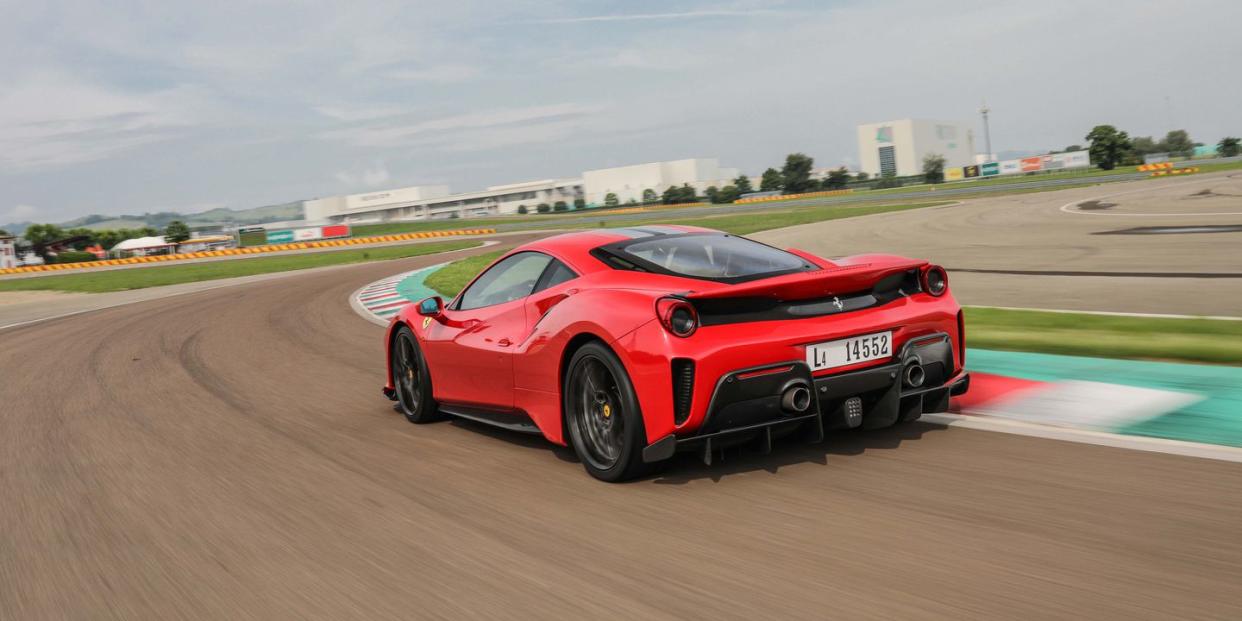
A 488 GTB turned so far past 11 the knob’s gone for a second lap, the 488 Pista is named after the Italian word for ‘track’ and according to Ferrari has more motorsport knowhow than any other road car it's ever built. A full review is coming from our two days thrashing it in the mountains, on the freeway and around Ferrari’s own Fiorano race circuit, but for now, here's what you should know up front.
The engine is basically straight out of the 488 Challenge race car
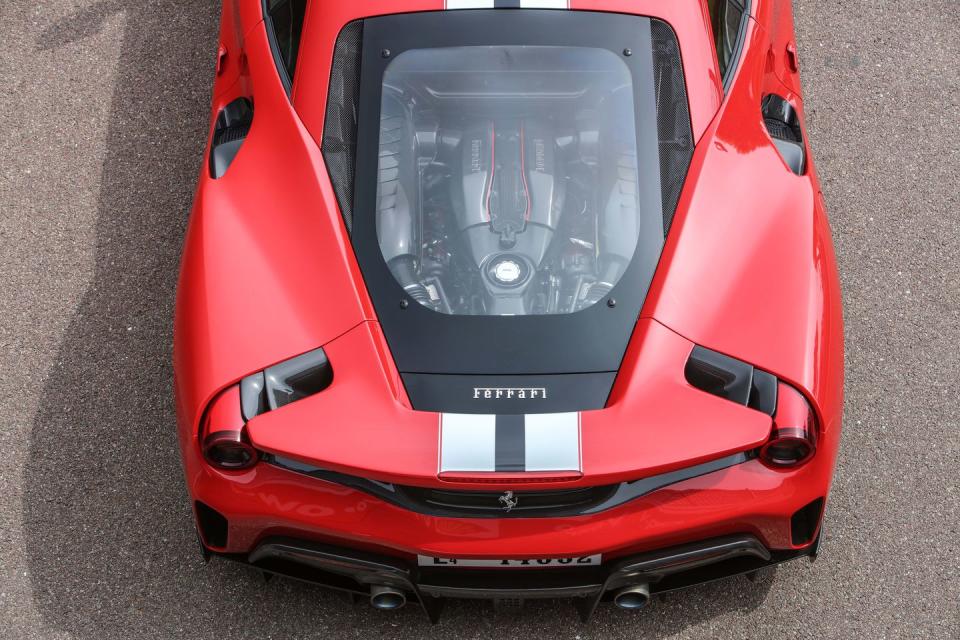
Okay, so they’re not exactly identical–boring stuff like noise regulations see to that–but this motor has far more in common with the one-make-series Challenge racer’s than a stock 488’s. Compared with the GTB, over 50 percent of the components are new. It’s still a 3.9-liter V8 but there are shorter intake runners, fancy Inconel alloy exhaust manifolds, new cams, a lighter flywheel and titanium rods.
What’s that all worth compared to a GTB? Not much up to 4000rpm, but a whole lot beyond it. A 488 GTB makes a stomping 661bhp (670ps) and 561lb of torque, and the Pista’s direct predecessor, the naturally aspirated 458 Speciale pumped out 597bhp (605ps) and a comparatively Fiat 500-like 398lb ft. This thing churns the dyno to the tune of 710bhp (720ps) and 568 lb ft. It is an absolute monster, and almost, almost, lag free. You have to wait a beat for the push in the back in the upper gears, but if you’ve got the right gear selected and you crack the throttle open it’s like booting up a flash drive to a traditional turbo car’s HDD. Zero to 62mph takes 2.85sec and it’ll lap Ferrari’s Fiorano track in 1min 21.5sec. A regular 488 GTB does the same in 3sec and 1min 23sec, respectively.
It’s cut like a Mr Olympia on contest day

Those 710 horses only have to drag 3053lb around because the Pista weighs 198lb less than a stock 488. Some of that weight comes from the engine, which is 40lb lighter; other savings are down to tossing the carpets and some sound insulation, fitting a lithium ion battery and lightweight buckets, Lexan rear window and building the hood, fenders, rear wing and bumpers from carbon fiber.
The impact on the way the 488 drives is unmissable. That lower curb weight combined with slightly stiffer suspension and a much stiffer sidewall from a new-compound Michelin Pilot Sport Cup 2 tire means this is the best-steering Ferrari you can by.
A 458 still sounds better
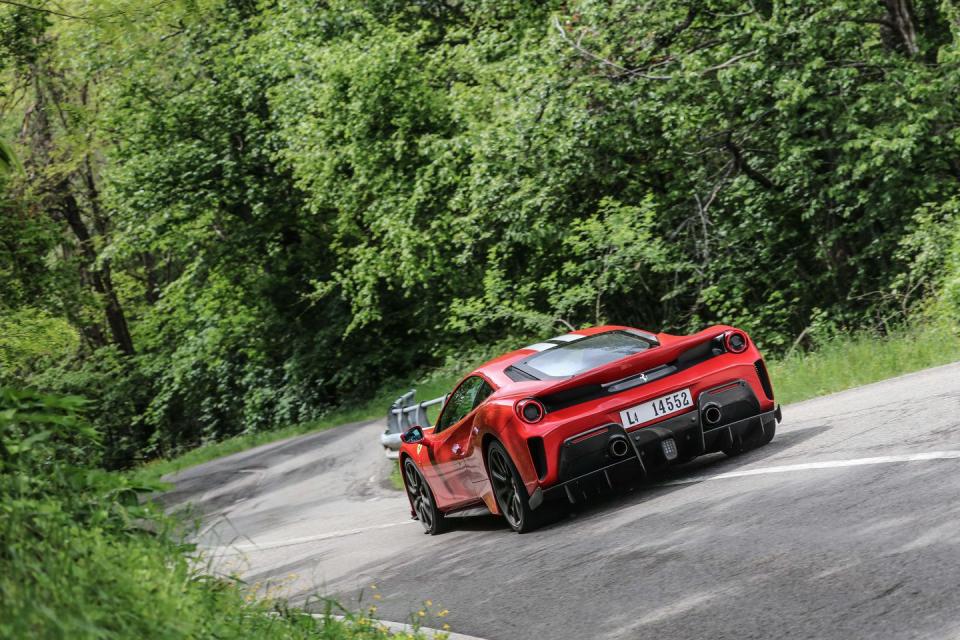
Turbo engines suck because all that blowing–or blow because all that sucking–spoils the acoustics. Ferrari’s engineers have worked hard to improve the sound of its turbo V8, which is around 8dB louder in the cabin compared to a standard car. And if we’d never heard a Speciale, or even a regular 458, screaming to 9000rpm, we’d be pretty content right now with how the Pista sounds at its 8000rpm redline. But you can’t forget something like the Speciale.
The flipside is that this is a way more usable car than the old Speciale, or the Pista’s close rival, Porsche’s 911 GT2 RS. Snick it into seventh gear and cruise down the autostrada at just under 3000rpm and even without carpets–and with a noticeably stiffer ride than standard-its actually really civilized. If we had a garden full of four leaf clovers and both a GT2 RS and a Pista in the garage and wanted to drive across country to some far-flung track weekend shindig, we’d reach for the Ferrari keys first.
With Ferrari Dynamic Enhancer everyone can be a hero

Ferrari Dynamic Enhancer? It sounds like some kind of erectile dysfunction remedy but is actually a very clever integrated stability control system that helps turn anyone into a driving deity. Back at the launch of this car’s predecessor, Ferrari revealed its ‘Side Slip Control,’ which integrated the e-diff, dampers, traction control to help even noobs feel comfortable beyond the limit of grip. Now it’s added a braking function too, which gently adds brake pressure on the appropriate rotor to maintain what it estimates to be the perfect yaw angle for the corner so that drivers can ‘easily handle even lengthy oversteer situations.'
You engage it by winding the little Manettino toggle on the steering wheel round past ‘Race’ mode, which is all about being fast, but neat, to ‘CT off.' It works brilliantly, and so subtly, you’ll soon kid yourself it’s you and not the car that’s got all the talent. Long, fast corners are where it does its thing best, allowing you to push the tail a surprisingly long way out, though you can’t expect the car to all the work - you still need to throw in some corrective lock. You can go crazier still if you turn the entire stability system off, but even drivers talented enough to do that will probably find themselves sticking with the CT-off. It’s just as fun and whole lot less scary, regardless of who’s picking up the repair tab.
The S-duct in the nose is an F1 borrow

One of the coolest details on the 458 is that scoop running right through the middle of the hood. Called an S-duct because of its serpentine shape, it channels air through the nose and exits at the maximum point of curvature on the hood, sucking that air to the bodywork to create downforce. The downside is that it eats into trunk space, which drops from 8.1 cu ft to six–still plenty of space for a helmet and race overalls, or the spare pair of pants you’ll need the first time you give the Pista full throttle in CT-off.
Other aero ideas pinched from motorsport include a rear diffuser inspired by the massively successful 488 GTE racer. Combine that with the new kicked-up (but static) fixed rear wing that looks epic every time you clock it in the rear view mirror and you’ve got the kit to deliver 529lb of downforce at 124mph.
It comes with Ferrari’s first ever carbon wheels

Carbon rims are nothing new–they’ve been around in the tuning world for years and more recently come fitted to production cars as diverse as Ford’s Mustang GT350R and GT supercar, and more recently on the gilt-edged Porsche 911 Turbo Exclusive Series.
But this is the first time they’ve fitted to a Ferrari. They’re not standard, they’re a €15,000 (roughly $17,700; US prices TBD) option, but as well as lightening your wallet they lighten the Pista’s weight by 2.2lb in total. That might not sound much but it’s all unsprung mass, remember.
Can you feel the difference? Sure, if you’re Ferrari’s test driver, Raffaele de Simone. But since we drove the carbon car on track and a car with forged rims on the street it was hard to make direct comparisons. Even Raffa concedes customers will probably only buy them because they look nuts. Unfortunately Ferrari doesn’t offer the one companion option you are going to need and that’s a portable bridge to reach the sidewalk: you’ll be so terrified of gouging these babies you’ll be parking a yard from the curb.
The stripes are optional
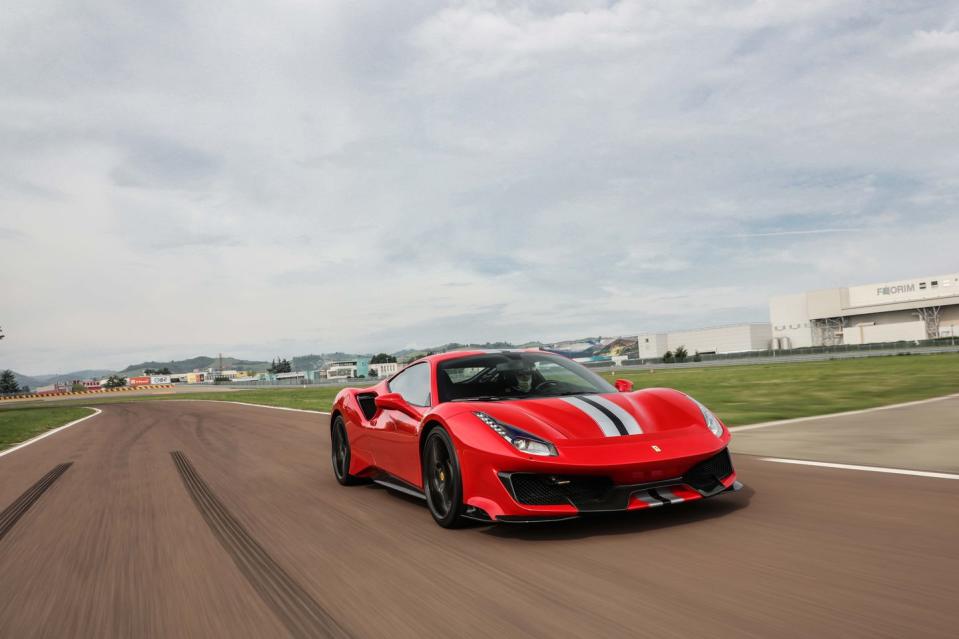
We all like to nod approvingly when we see a de-badged performance car, but it’s hard to imagine buying a Pista without those optional stripes, which come in different styles and colors. We’re still waiting to find out the exact USD price but based on European prices we’re looking at around $11,500 to get the stripes.
Harnesses are a nightmare on a road car

Also optional–and best left as an option unless you plan to build a house in the pitlane at Lime Rock–are the race-harnesses. They look cool, but rest assured, after seven hours on Italian autostradas, struggling to reach out of the window to pay tolls had us crying out for boring old belts. Even Ferrari admits that only 60 percent of buyers will ever venture on track, and even then, it might only be once. But if you must, reckon on spending around $2800.
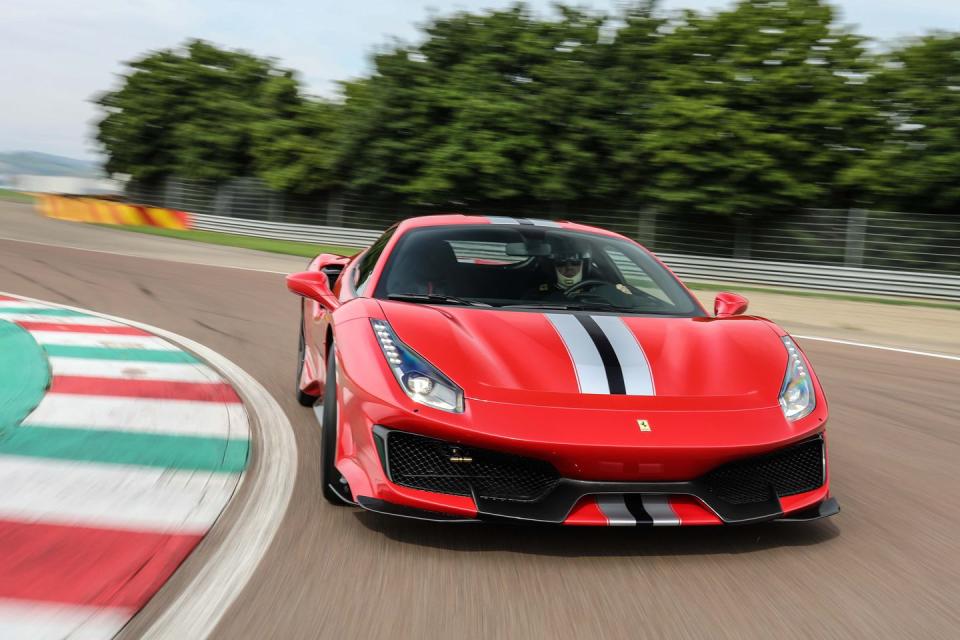
You Might Also Like

 Yahoo News
Yahoo News 
